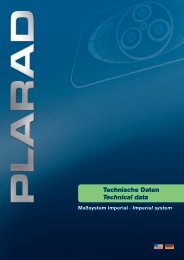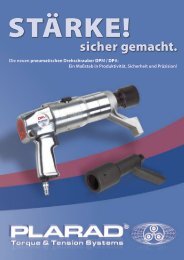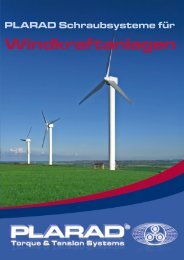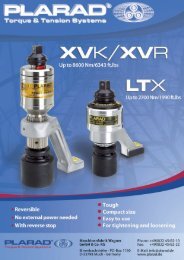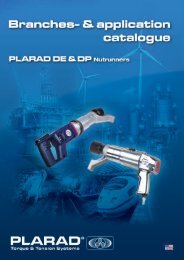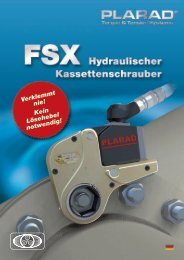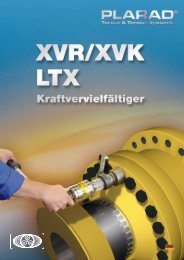Create successful ePaper yourself
Turn your PDF publications into a flip-book with our unique Google optimized e-Paper software.
hout stress!<br />
Day of the demonstration:<br />
A bus with hub-centred wheel rims was provided as<br />
the test object. The bus tyres had had an uninterrupted<br />
service life of approx. 46,000 km. The tightening torque<br />
for the wheel nuts was 600 Nm.<br />
The tools provided by Maschinenfabrik Wagner were<br />
one pneumatic and one electrical bolting tool. First, the<br />
breakaway torque of the wheel nuts on the bus was<br />
measured. This torque was > 1000 Nm. It is amazing<br />
how the tightness of wheel nuts develops after running<br />
such a distance. No wonder normal pneumatic bolting<br />
tools have great diffi culty in releasing these nuts.<br />
The engineers at Wagner know the torque developed by<br />
their products, so, fi rst of all, the pneumatic bolting tool<br />
had to show what it was capable of. With a controlled<br />
air pressure of 4.5 bar and with a soft whir, the wheel<br />
nuts came off as if turned by hand. No noise could be<br />
heard and no vibration was felt in the hands and arms<br />
of the fi tter. Tightening the wheel nuts with a torque of<br />
600 Nm was carried out with a controlled air pressure<br />
of 1.9 bar and was even quieter. Wonderful! Peace and<br />
safety at last for both workers and material. Our fi tters<br />
now looked sceptically at the electrical bolting tool. The<br />
level of the rotary force was set on the potentiometer.<br />
A slight anti-clockwise movement with the sound of a<br />
slowly turning drill, and the wheel nuts were loose. We<br />
were amazed. We had never seen wheel nuts unscrewed<br />
so quickly and so easily. And the tightening went just as<br />
smoothly as the loosening. With no exaggeration,<br />
brilliant. That was the solution for us!<br />
We bought one of each bolting tool. In the following<br />
months, individual extensions and accessories were<br />
specially produced for our requirements. Setting values<br />
for a wide range of torques were documented for the<br />
<strong>news</strong><br />
bolting tools. Today, the handling of these bolting tools<br />
during our bus repairs has been perfected. We loosen<br />
and tighten more and more with high torque values.<br />
The handling and effi ciency of these bolting tools have<br />
enormous advantages in practical occupational safety.<br />
The fl exibility of the electrical bolting tool would have<br />
saved us many headaches over the years in the<br />
loosening and tightening of bolted joints. We are<br />
currently planning to fi t an inverter from 24 V to 220 V in<br />
our breakdown truck so that we can use the electrical<br />
bolting tool for fi tting work on the wheels of our vehicles.<br />
Unfortunately, there is also a drawback. These bolting<br />
tools are very costly to procure. But when the frequency<br />
of use and the personal safety benefi ts for our fi tters<br />
are taken into account, their procurement is absolutely<br />
economical in the long term.” ■<br />
For more information, contact:<br />
Ralf König, Master Automotive Technician<br />
r. koenig@stadtwerke-remscheid.de<br />
7



